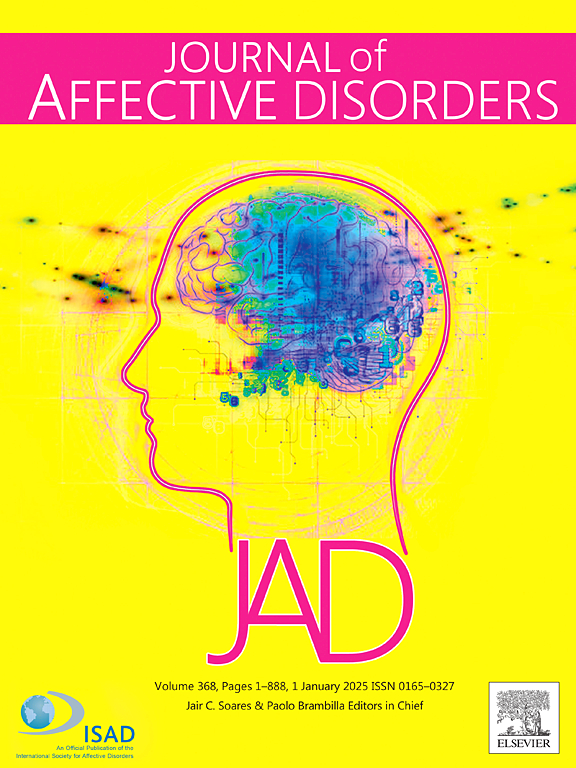Consistent differential effects of bupropion and mirtazapine in major depression
IF 4.9
2区 医学
Q1 CLINICAL NEUROLOGY
引用次数: 0
Abstract
Background
Patients with major depression exhibit heterogeneous symptom profiles and variable responses to antidepressants. Most clinical trials rely on aggregate outcomes such as total symptom severity or remission rates, which often obscure meaningful differences in treatment response.
Methods
We applied the Supervised Varimax (SV) algorithm to identify outcome dimensions that maximally differentiate antidepressants based on symptom-level effects. We analyzed all relevant levels of the STAR*D trial and validated findings in the independent CO-MED study. We assessed statistical significance using permutation testing with familywise error rate (FWER) correction.
Results
SV consistently identified interpretable and statistically significant differences between bupropion, mirtazapine, and other antidepressants. In STAR*D, bupropion monotherapy produced greater improvement in hypersomnia than venlafaxine in Levels 2 and 2 A (, difference = , ). Bupropion augmentation outperformed buspirone augmentation for increased weight, increased appetite, and fatigue in Level 2 (, difference = , ). Mirtazapine monotherapy outperformed nortriptyline for insomnia, decreased weight, and decreased appetite in Level 3 (, difference = , ), and venlafaxine with mirtazapine similarly outperformed tranylcypromine in Level 4 (, difference = , ). In CO-MED, escitalopram with bupropion and venlafaxine with mirtazapine demonstrated complementary symptom-specific benefits (, difference = , ).
Conclusion
Bupropion is most effective for hypersomnia, increased weight, increased appetite, or fatigue, while mirtazapine is preferable for insomnia, decreased weight, or decreased appetite. SV enables statistically rigorous, symptom-level differentiation using only treatment assignment, offering a scalable and clinically aligned framework for guiding antidepressant selection from individual clinical trials.
安非他酮与米氮平治疗重度抑郁症的一致性差异效应。
背景:重度抑郁症患者表现出不同的症状特征和对抗抑郁药物的不同反应。大多数临床试验依赖于总体结果,如总症状严重程度或缓解率,这往往掩盖了治疗反应的有意义差异。方法:我们应用监督方差(SV)算法来识别基于症状水平效应最大程度区分抗抑郁药的结果维度。我们分析了STAR*D试验的所有相关水平,并验证了独立CO-MED研究的结果。我们使用家庭误差率(FWER)校正的排列检验来评估统计显著性。结果:SV一致地确定了安非他酮、米氮平和其他抗抑郁药之间的可解释和统计学上的显著差异。在STAR*D中,安非他酮单药治疗对2级和2级 A患者嗜睡的改善效果优于文拉法辛(n=686,差异= 0.384,pFWER=0.007)。在水平2中,安非他酮增强治疗在增加体重、增加食欲和疲劳方面优于丁螺环酮增强治疗(n=520,差异= -0.322,pFWER=0.005)。米氮平单药治疗失眠、体重减轻和食欲下降的效果优于去甲替林3级(n=214,差值= 0.401,pFWER=0.022),文拉法辛联合米氮平在4级同样优于丙氨嘧啶(n=102,差值= -0.722,pFWER=0.004)。在CO-MED中,艾司西酞普兰与安非他酮和文拉法辛与米氮平表现出互补的症状特异性获益(n=640,差异= -0.302,pFWER=0.022)。结论:安非他酮对嗜睡、体重增加、食欲增加或疲劳最有效,而米氮平对失眠、体重减轻或食欲下降更有效。SV使统计上严格,症状水平的区分仅使用治疗分配,提供一个可扩展的和临床一致的框架,指导抗抑郁药的选择从个别临床试验。
本文章由计算机程序翻译,如有差异,请以英文原文为准。
求助全文
约1分钟内获得全文
求助全文
来源期刊

Journal of affective disorders
医学-精神病学
CiteScore
10.90
自引率
6.10%
发文量
1319
审稿时长
9.3 weeks
期刊介绍:
The Journal of Affective Disorders publishes papers concerned with affective disorders in the widest sense: depression, mania, mood spectrum, emotions and personality, anxiety and stress. It is interdisciplinary and aims to bring together different approaches for a diverse readership. Top quality papers will be accepted dealing with any aspect of affective disorders, including neuroimaging, cognitive neurosciences, genetics, molecular biology, experimental and clinical neurosciences, pharmacology, neuroimmunoendocrinology, intervention and treatment trials.
 求助内容:
求助内容: 应助结果提醒方式:
应助结果提醒方式:


